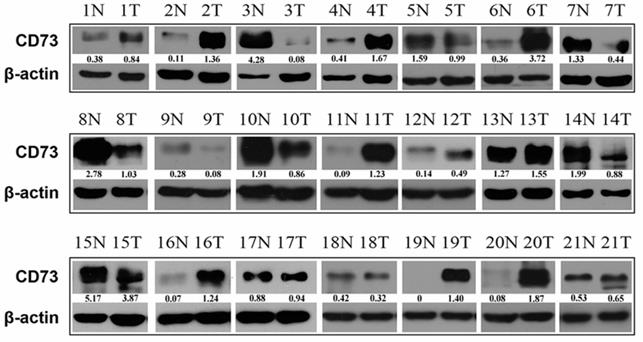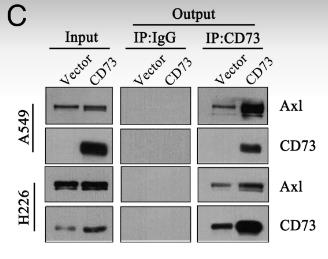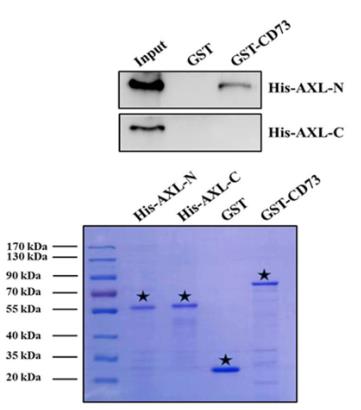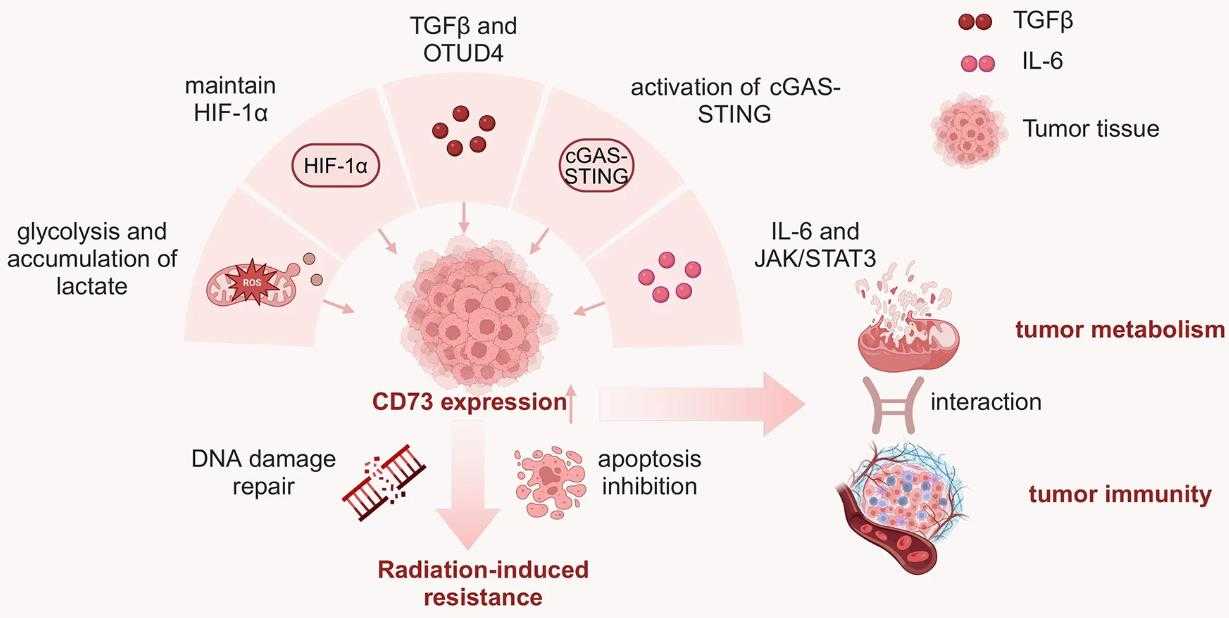Recombinant Cynomolgus NT5E protein(Met1-Lys547), His-tagged
| Cat.No. : | NT5E-8848C |
| Product Overview : | Recombinant Cynomolgus NT5E (EHH53214.1) (Met1-Lys547) was expressed in HEK293 with a polyhistidine tag at the C-terminus. |
- Specification
- Gene Information
- Related Products
- Case Study
- Application
- Download
| Species : | Cynomolgus |
| Source : | HEK293 |
| Tag : | His |
| Protein Length : | 1-547 a.a. |
| Form : | Lyophilized from sterile 20 mM Tris, 0.12 M NaCl, 4 mM CaCl2, 20% glycerol, pH 7.5. Normally 5 % - 8 % trehalose, mannitol and 0.01% Tween80 are added as protectants before lyophilization. |
| Bio-activity : | Measured by its ability to hydrolyze the 5'-phosphate group from the substrate adenosine-5'-monophosphate (AMP). The orthophosphate product is measured by a Malachite Green Phosphate Detection Kit. The specific activity is >20, 000 pmol/min/μg. |
| Molecular Mass : | The recombinant cynomolgus NT5E comprises 532 amino acids and has a calculated molecular mass of 59.2 KDa. The apparent molecular mass of it is approximately 59 KDa respectively in SDS-PAGE. |
| Endotoxin : | < 1.0 EU per μg of the protein as determined by the LAL method |
| Purity : | > 90 % as determined by SDS-PAGE |
| Storage : | Samples are stable for up to twelve months from date of receipt at -20°C to -80°C. Store it under sterile conditions at -20°C to -80°C. It is recommended that the protein be aliquoted for optimal storage. Avoid repeated freeze-thaw cycles. |
| Reconstitution : | It is recommended that sterile water be added to the vial to prepare a stock solution of 0.2 ug/ul. Centrifuge the vial at 4°C before opening to recover the entire contents. |
| ◆ Recombinant Proteins | ||
| Nt5e-34R | Recombinant Rat Nt5e, His tagged | +Inquiry |
| NT5E-1302H | Recombinant Human NT5E Protein, GST-tagged | +Inquiry |
| NT5E-151H | Recombinant Human NT5E Protein, His-tagged | +Inquiry |
| NT5E-4740H | Recombinant Human NT5E Protein (Met1-Ser549), C-His tagged | +Inquiry |
| NT5E-1951H | Recombinant Human NT5E protein, hFc-tagged | +Inquiry |
| ◆ Cell & Tissue Lysates | ||
| NT5E-2491MCL | Recombinant Mouse NT5E cell lysate | +Inquiry |
| NT5E-2073HCL | Recombinant Human NT5E cell lysate | +Inquiry |
| NT5E-1153CCL | Recombinant Cynomolgus NT5E cell lysate | +Inquiry |
| NT5E-1082RCL | Recombinant Rat NT5E cell lysate | +Inquiry |
Case 1: Zhu J, et al. Mol Cancer. 2017
CD73 (ecto-5'-nucleotidase) plays a critical role in cancer development, with current clinical trials testing CD73 inhibitors for cancer treatment. Understanding their molecular and cellular mechanisms is essential for improving these therapies. Research revealed that CD73 is overexpressed while miR-30a-5p is underexpressed in non-small cell lung cancer tissues. CD73 is a direct target of miR-30a-5p, with experiments showing that miR-30a-5p overexpression inhibits cancer cell proliferation, migration, and invasion both in vitro and in vivo by suppressing the epithelial-to-mesenchymal transition via the EGF signaling pathway.

Fig1. Western blot analysis of the CD73 protein levels in 21 randomly selected NSCLC tissues and paired noncancerous lung tissues.

Fig2. miR-30a-5p inhibits tumor growth by targeted CD73 in vivo.
Case 2: Zhu J, et al. Proc Natl Acad Sci U S A. 2024
CD73 dephosphorylates adenosine monophosphate (AMP), influencing tumor cell proliferation and metastasis. Its role in non-small cell lung cancer (NSCLC) metastasis, particularly through the CD73/Axl axis, has been highlighted as it facilitates Smad3-induced epithelial-to-mesenchymal transition (EMT), promoting metastasis. CD73 is secreted via the Golgi apparatus and can activate Axl by binding to its extracellular site R55 independently of GAS6, while also stabilizing Axl by inhibiting CBLB expression. This study underscores CD73's distinct functions in adenocarcinoma and squamous cell carcinoma, suggesting its potential as a therapeutic target for NSCLC management.

Fig1. Co-IP assay was performed to assess the interaction between CD73 and Axl.

Fig2. Detection of GST-CD73 bound to His-Axl-N or His-Axl-C by GST pull-down assay.
Recombinant Cynomolgus NT5E protein, also known as CD73, is a multifunctional protein with significant applications in research and medicine. It is involved in the conversion of extracellular nucleotides to adenosine, a signaling molecule that plays a role in immune responses and tissue repair. Here's a summary of its background and applications:
Cancer Research: NT5E is overexpressed in various cancer types, including lung adenocarcinoma, pancreatic cancer, and glioma. It contributes to tumor growth, metastasis, and resistance to immunotherapy by promoting an immunosuppressive tumor microenvironment. The enzyme generates adenosine, which suppresses the antitumor effects of immune cells such as CD8+ T cells and NK cells.
Immune Regulation: NT5E-derived adenosine mediates immunosuppression, particularly by activating the A2A receptor on immune cells. This pathway is crucial for tumor escape from immune surveillance, and targeting NT5E can enhance the efficacy of other immune checkpoint inhibitors, making it a potential therapeutic target for cancer immunotherapy.
Drug Development: As a key enzyme in the ATP-to-adenosine degradation pathway, NT5E is a rate-limiting factor in the formation of immunosuppressive adenosine. Inhibitors of NT5E are being developed to disrupt this pathway and enhance antitumor immunity, with some showing promise in preclinical studies.
Prognostic Biomarker: High NT5E expression is associated with poor prognosis in several cancers, including pancreatic adenocarcinoma and head and neck squamous cell carcinoma. It is also linked to lymph node metastases, making it a potential biomarker for cancer prognosis and treatment response.
Disease Model Research: Recombinant NT5E protein is used in preclinical models to study the pathogenesis of diseases, such as chronic inflammation and immune dysregulation, which helps in identifying potential therapeutic targets.

Fig1. The clinical prospects of targeting CD73 for cancer therapy. (Jianhao Zhan, 2024)
Not For Human Consumption!
Inquiry
- Reviews
- Q&As
Ask a Question for All NT5E Products
Required fields are marked with *
My Review for All NT5E Products
Required fields are marked with *
Inquiry Basket


